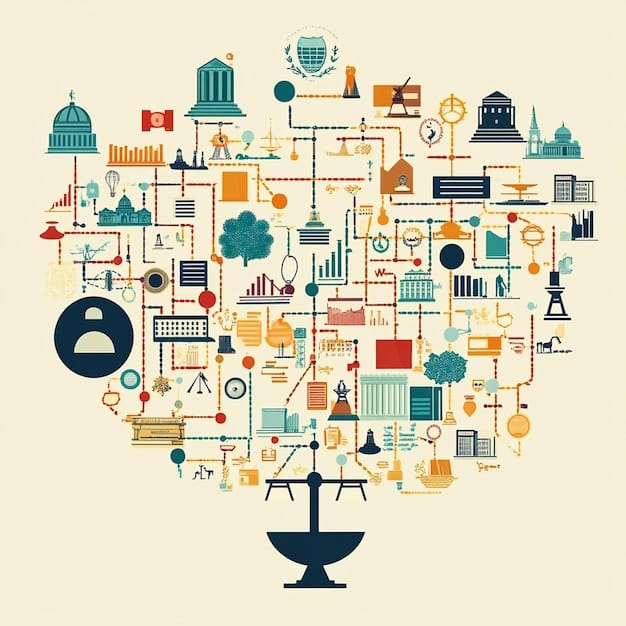The Future of Work: Preparing for Automation and AI in the US Job Market

Navigating the Future of Work: Preparing for Automation and AI in the US Job Market requires proactive strategies, continuous skill development, and adaptability to evolving technologies to maintain career viability and thrive amidst significant disruptive shifts.
The landscape of employment is undergoing a transformative shift, profoundly impacted by advancements in artificial intelligence (AI) and automation. Understanding the evolving dynamics of the Future of Work: Preparing for Automation and AI in the US Job Market is not merely an academic exercise; it’s an urgent necessity for professionals across all sectors.
The Automation Revolution: Beyond Repetitive Tasks
The notion that automation primarily threatens routine, manual labor is an oversimplification. While manufacturing and logistics have been early adopters, the pervasive reach of AI and robotics now extends into white-collar professions, challenging roles once considered immune to technological disruption. This new wave of automation, fueled by sophisticated algorithms and machine learning, is capable of processing complex data, performing analytical tasks, and even engaging in creative endeavors previously exclusive to human intellect.
Understanding the Scope of Disruption
The impact isn’t just about job displacement. It’s about job transformation. Many roles will not disappear but will be augmented, requiring new competencies to collaborate effectively with intelligent systems. For economists and labor market analysts, the key challenge lies in predicting which specific tasks within occupations are most susceptible to automation, rather than merely categorizing entire jobs. This granular understanding allows for more targeted reskilling and upskilling initiatives.
- Cognitive Automation: AI systems are increasingly handling tasks requiring decision-making, pattern recognition, and data interpretation, impacting fields like finance, healthcare, and law.
- Robotics Process Automation (RPA): Software bots automating repetitive, rule-based digital processes across various industries, from customer service to back-office operations.
- Advanced Robotics: Beyond manufacturing, robots are gaining dexterity and intelligence, moving into service industries, healthcare, and even construction.
As organizations adopt these technologies, there is an immediate need to re-evaluate internal workflows and workforce capabilities. The goal is to leverage automation for efficiency and productivity gains, freeing human employees to focus on higher-value, more creative, and interpersonally complex tasks. This symbiotic relationship, where humans and AI collaborate, is emerging as the defining characteristic of the future workplace. Businesses that fail to grasp this distinction risk falling behind, while those that embrace it stand to gain significant competitive advantages. It becomes less about “humans versus machines” and more about “humans with machines.”
AI-Driven Transformation: Reshaping Industries and Roles
Artificial intelligence is not just a tool; it’s a fundamental paradigm shift that redefines how industries operate, how decisions are made, and ultimately, what skills are valued in the workforce. From predictive analytics in retail to diagnostic assistance in medicine, AI’s capabilities are expanding at an unprecedented rate, creating both immense opportunities and significant challenges for human employment.
The pervasive influence of AI is evident in virtually every sector. In finance, algorithmic trading and fraud detection systems now operate with efficiency far beyond human reach, enabling faster, more accurate transactions and risk assessments. Retail is using AI for hyper-personalized marketing and inventory optimization, transforming the customer experience and supply chain management. In healthcare, AI aids in drug discovery, image analysis, and even robotic surgery, enhancing diagnostic accuracy and treatment efficacy.
This technological evolution demands a shift in educational priorities. Traditional curricula, often focused on rote memorization and procedural knowledge, must evolve to emphasize critical thinking, problem-solving, and adaptability. The rapid pace of AI development means that continuous learning will become a non-negotiable aspect of professional life. Individuals and organizations must invest in lifelong learning pathways to remain competitive.
Emerging AI Capabilities and Their Impact
The sophistication of AI models, particularly in areas like natural language processing (NLP) and machine learning, means that tasks once thought exclusively human are now within AI’s grasp. This includes content generation, data analysis, and even elements of creative design. Such capabilities are not merely replicating human actions but often augmenting them, performing tasks with greater speed and accuracy.
- Generative AI: Tools like ChatGPT and DALL-E are automating content creation, from marketing copy to initial design concepts, impacting creative and media roles.
- Predictive Analytics: AI-powered insights are driving strategic decisions in sales, operations, and human resources, requiring professionals who can interpret and act on these insights.
- Autonomous Systems: From self-driving vehicles to automated warehousing, AI is orchestrating complex physical operations, particularly in logistics and transportation.
The integration of these AI capabilities often leads to a phenomenon where humans transition from executing tasks to managing and refining AI systems. This requires a different set of skills: an understanding of AI ethics, data governance, and the ability to troubleshoot and optimize AI performance. The human role shifts from doing to overseeing, from creating from scratch to curating and enhancing AI-generated outputs. This evolution necessitates a partnership between human ingenuity and artificial intelligence, where each complements the other’s strengths.
Essential Skills for the Automated Future
As automation and AI redefine professional landscapes, the focus shifts from possessing specific job titles to cultivating a robust and adaptable skill set. The skills most resistant to automation are those that leverage uniquely human attributes: creativity, critical thinking, complex problem-solving, social intelligence, and adaptability. These are the competencies that algorithms currently struggle to replicate, making them invaluable in a world increasingly powered by machines.
The ability to navigate ambiguity, synthesize disparate information, and innovate will be paramount. Traditional education systems are beginning to incorporate these “21st-century skills” more explicitly, moving away from rote memorization towards project-based learning and collaborative problem-solving. However, individual responsibility for lifelong learning will remain critical.
Cultivating Human-Centric and Digital Literacies
A balanced approach is required: developing a deep understanding of human dynamics while simultaneously embracing digital fluency. It’s not enough to be technically proficient; one must also be emotionally intelligent and creatively agile. This dual mastery allows individuals to effectively leverage technology to solve human problems.
- Critical Thinking & Problem-Solving: The ability to analyze information, identify core issues, and develop innovative solutions, especially for ill-defined problems.
- Creativity & Innovation: Generating new ideas, approaches, and solutions, particularly in areas where AI provides data but lacks the intuitive leap of human imagination.
- Digital Fluency & Data Literacy: Understanding how to use digital tools, interpret data, and work with AI systems, extending beyond basic computer skills.
- Emotional Intelligence & Collaboration: Skills in communication, empathy, negotiation, and teamwork, crucial for leading and collaborating in diverse, technologically augmented environments.

Furthermore, the concept of “metacognition” – thinking about one’s own thinking – will gain importance. Individuals who can assess their learning styles, identify skill gaps, and proactively seek out new knowledge will be best positioned for long-term career success. This self-directed learning, combined with a willingness to continuously unlearn and relearn, forms the cornerstone of future-proofing one’s career in an era of rapid technological change. Embracing this mindset allows professionals to not merely react to change, but to actively shape their careers.
Strategic Reskilling and Upskilling Initiatives
The imperative to reskill and upskill the workforce to meet the demands of an AI-driven economy is no longer a futuristic concept but a present-day reality. Both individuals and employers bear significant responsibility in this collective endeavor. For individuals, it means proactively assessing current skills against future needs and investing time in acquiring new competencies. For employers, it entails creating robust learning ecosystems, offering accessible training programs, and fostering a culture of continuous development.
Public-private partnerships are emerging as a crucial mechanism for addressing this challenge at scale. Governments, educational institutions, and corporations are collaborating to design curricula that are responsive to industry needs, provide funding for training initiatives, and ensure equitable access to these opportunities across various demographics. This collaborative approach recognizes that the scale of the challenge requires resources and expertise beyond that of any single sector.
Pathways for Continuous Learning
The traditional model of front-loaded education followed by a static career is rapidly becoming obsolete. The future demands a fluid, dynamic approach to learning where skill acquisition is an ongoing process, intertwined with professional life. This adaptability will be a key differentiator in a competitive job market.
- Micro-credentials & Bootcamps: Short, intensive programs focused on specific, in-demand skills, offering faster pathways to new competencies.
- Online Learning Platforms: Accessible courses from top institutions and experts, enabling flexible, self-paced skill development.
- Internal Training & Development: Companies investing in their existing workforce through tailored programs, workshops, and rotational assignments.
- Apprenticeships & On-the-Job Learning: Blending theoretical instruction with practical application, providing hands-on experience with new technologies.
Beyond formal programs, informal learning methods are also gaining prominence. This includes participation in online communities, engaging in peer-to-peer learning, attending virtual conferences, and leveraging open educational resources. The key is to cultivate a learning mindset, viewing every challenge as an opportunity to acquire new knowledge or refine existing skills. This ongoing commitment to personal and professional growth not only enhances individual career prospects but also strengthens the collective adaptive capacity of the entire workforce.
The Evolving Nature of Work and Employment Models
The rise of automation and AI is not just changing what we do, but how we work and the very structure of employment. The traditional 9-to-5, full-time employment model is being supplemented, and in some cases supplanted, by more flexible, dynamic arrangements. The gig economy, remote work, and project-based assignments are becoming increasingly common, offering both opportunities for autonomy and challenges related to stability and benefits.
This decentralization of work is driven by technological capabilities that allow for seamless collaboration across geographical boundaries and time zones. Companies can tap into a global talent pool, while individuals gain greater flexibility in managing their work-life balance. However, this shift also necessitates new frameworks for labor laws, social safety nets, and professional development to ensure that all workers, regardless of their employment model, are adequately supported.
Emerging Work Paradigms
The concept of a “career path” is also evolving. Instead of a linear progression within a single organization or industry, individuals may increasingly find themselves navigating a series of projects, roles, and even career pivots. This requires a proactive approach to career management, where personal branding, networking, and continuous skill adaptation are paramount.
- Hybrid Work Models: Blending remote and in-office work, offering flexibility while maintaining opportunities for in-person collaboration.
- Gig Economy Expansion: More professionals engaging in short-term contracts, freelancing, and project-based work, particularly in specialized AI-related fields.
- Human-AI Teaming: Workflows designed around humans supervising or collaborating directly with AI systems, requiring new forms of team dynamics and leadership.
- “Portfolio Careers”: Individuals managing multiple income streams and diverse professional engagements simultaneously, building a varied skill portfolio.
The implications extend to organizational design. Hierarchical structures are giving way to more agile, networked teams that can quickly adapt to changing market conditions. This demands a different style of leadership – one that is facilitative, inclusive, and focused on empowering individuals to innovate. The future workplace will be characterized by fluidity, adaptability, and a constant re-evaluation of how work gets done most effectively, leveraging the unique strengths of both human and artificial intelligence.
Policy Implications and Societal Considerations
The profound impact of automation and AI on the US job market transcends individual career choices, raising critical policy questions and demanding careful societal considerations. Governments, policymakers, and civil society organizations face the complex task of mitigating potential negative consequences—such as widespread job displacement and increased economic inequality—while maximizing the benefits of technological progress. This requires a holistic approach that considers economic, ethical, and social dimensions.
One of the central debates revolves around income disparity. If automation indeed leads to a significant reduction in human labor requirements for certain tasks, how will wealth be distributed? Ideas like universal basic income (UBI) and revised social welfare programs are gaining traction as potential mechanisms to cushion the economic transitions for those most affected.
Addressing the Broader Impact
Beyond direct employment, AI and automation have implications for education systems, urban planning, and even fundamental human rights in the digital age. Policymakers must proactively engage with these challenges to build a resilient and equitable future. This includes discussions on data privacy, algorithmic bias, and the ethical deployment of AI in sensitive sectors.
- Education Reform: Realigning K-12 and higher education curricula to emphasize future-ready skills, including digital literacy and critical thinking.
- Labor Market Policies: Developing new social safety nets, retraining programs, and potentially exploring wage subsidies or universal basic income.
- Regulatory Frameworks: Crafting ethical guidelines and regulations for AI development and deployment, particularly concerning bias, transparency, and accountability.
- Investment in Infrastructure: Ensuring robust digital infrastructure and equitable access to technology and high-speed internet across all communities.
Policymakers also grapple with the concept of “technological unemployment,” where jobs are permanently lost due to automation without new ones being created at a sufficient pace. Addressing this requires not only reskilling initiatives but also fostering an environment conducive to innovation and new business creation. Economic diversification, investment in research and development, and support for entrepreneurship are vital components of a comprehensive strategy. The journey through this technological transformation necessitates not just technical solutions, but robust public dialogue and political will to shape a future that benefits all segments of society.

Preparing for a Human-AI Collaborative Future
The ultimate trajectory of the US job market is less about humans being replaced by machines and more about a fundamental shift towards human-AI collaboration. This future requires a collective mindset of adaptability, curiosity, and continuous improvement. Individuals must embrace lifelong learning, cultivating both their distinctly human capabilities and their digital fluency.
Employers, meanwhile, have a critical role in fostering supportive environments that prioritize reskilling, invest in employee growth, and strategically integrate AI to augment human potential, rather than simply automate it away. This involves a culture shift where technology is seen as a partner, not solely a cost-cutting measure.
Key Recommendations for Readiness
Navigating this complex transition requires foresight and proactive engagement from all stakeholders. The coming decades will demand an unprecedented level of cooperation between government, industry, academia, and individuals to create a resilient and prosperous workforce. Ignoring these trends is no longer an option.
- Individuals: Proactively identify high-demand skills, embrace continuous learning, and build strong professional networks.
- Businesses: Invest in workforce development, implement AI ethically and strategically, and foster a culture of innovation and adaptability.
- Policymakers: Develop responsive education models, explore new social safety nets, and implement forward-thinking regulations for AI and labor.
The pathway forward is not without its complexities or uncertainties. However, with deliberate preparation, strategic investment in human capital, and a commitment to ethical technological integration, the future of work in the US can indeed be one of enhanced productivity, new opportunities, and increased human flourishing. The ultimate goal is to shape a future where technology serves humanity, creating a more inclusive and prosperous society for all.
| Key Point | Brief Description |
|---|---|
| 🔄 Automation Extends Beyond Manual Jobs | AI now impacts white-collar roles, transforming tasks rather than just eliminating jobs. |
| 🧠 Human-Centric Skills are Key | Creativity, critical thinking, and emotional intelligence are increasingly valuable. |
| 💡 Continuous Learning is Essential | Reskilling and upskilling through various pathways are vital for career longevity. |
| 🤝 Human-AI Collaboration is the Future | The job market will favor professionals who can effectively work alongside AI systems. |
Frequently Asked Questions About the Future of Work
While some roles or tasks may be automated, the more likely outcome is job transformation rather than wholesale elimination. AI will augment human capabilities, create new types of jobs, and increase productivity, requiring a workforce that can adapt and develop new skill sets, particularly those involving human-centric attributes.
Key skills include critical thinking, complex problem-solving, creativity, emotional intelligence, and digital literacy. These “soft” and “human” skills, combined with the ability to collaborate with AI and interpret data, will be crucial as technology handles more routine and analytical tasks.
Individuals can pursue micro-credentials, bootcamps, and online courses focused on in-demand skills. Engaging in continuous learning through professional development programs, apprenticeships, and even self-directed learning via online resources will be vital for staying competitive.
Traditional full-time roles are evolving. Increasingly, remote work, hybrid models, and project-based assignments within the gig economy are becoming prevalent. The emphasis shifts to flexible work arrangements and human-AI teaming, requiring new approaches to career management and organizational design.
Governments must implement education reforms, develop new labor market policies and social safety nets, and establish ethical regulatory frameworks for AI. Investment in digital infrastructure and fostering an environment for entrepreneurship are also critical to ensure a resilient and equitable transition.
Conclusion
The dynamic interplay of automation and AI is fundamentally reshaping the US job market, presenting both formidable challenges and unparalleled opportunities. Success in this evolving landscape hinges on a proactive and adaptable approach from individuals, businesses, and policymakers alike. By prioritizing continuous learning, cultivating distinctly human competencies like creativity and critical thinking, and embracing intelligent human-AI collaboration, the workforce can not only navigate these transformations but also thrive, unlocking new avenues for innovation and economic growth. The future of work is not a predetermined destination, but a landscape we actively co-create through strategic preparation and collective commitment.





